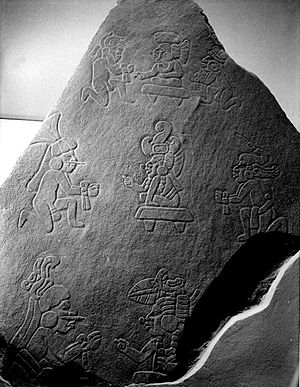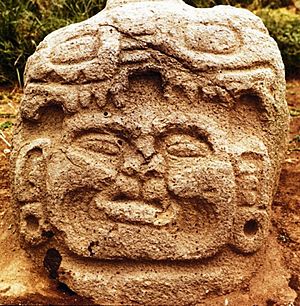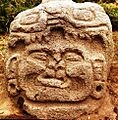Kaminaljuyu facts for kids
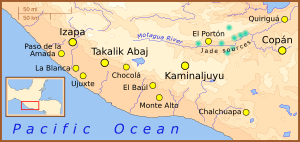
Kaminaljuyu and other Preclassic sites
|
|
| Race | Maya |
|---|---|
| Religion | Maya |
| Geographical range | Southern Maya area |
| Period | Preclassic and Classic |
| Dates | 1500 BC to 1200 CE |
| Characteristics | Use of hardened adobe to build instead of limestone |
Kaminaljuyu (pronounced /kæminælˈhuːjuː/) is an ancient Maya civilization site. Its name comes from the Kʼicheʼ word for "The Hill of the Dead." You can find it in modern-day Guatemala City.
People lived here from about 1500 BC to 1200 AD. Some experts call it one of the greatest ancient sites in the New World. However, much of it has been covered by the modern city.
When it was first mapped, Kaminaljuyu had about 200 platforms and pyramid-shaped mounds. Today, only a small part of the original site is left. This area is preserved as a park, covering about 0.5 square kilometers. The original site was much larger, around 5 square kilometers.
Contents
Discovering Kaminaljuyu
The ancient buildings at Kaminaljuyu were made from hardened adobe (a type of mud brick). This material is not as strong as the limestone used in other Maya cities. Because of this, and because the city grew on top of the ruins, many parts of Kaminaljuyu have been lost.
For over 100 years, many archaeological teams have worked at Kaminaljuyu. Scholars like Alfred Maudslay and Samuel K. Lothrop drew maps and recorded sculptures. In 1925, Manuel Gamio found old pottery pieces and clay figurines. These finds showed that people lived here as early as 1500 BC.
A big discovery happened in the 1930s. A local football club was clearing land for a practice field. They accidentally uncovered an amazing buried structure. This led archaeologists Alfred Kidder, Jesse Jennings, and Edwin Shook to investigate. The site was named Kaminaljuyu, meaning "mounds of the ancestors."
These early studies showed how important the site was. They found a large mound, E-III-3, which had seven structures built one over the other. Inside, they discovered two very rich royal tombs. These tombs likely belonged to important rulers from the "Miraflores" period.
Later, in the 1960s, Pennsylvania State University did more big excavations. In the 1990s, other teams, including a Japanese group, also explored the site. These efforts helped us learn a lot about this ancient city.
Life in Ancient Kaminaljuyu
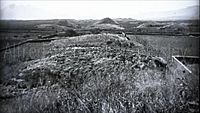
Kaminaljuyu sits on a wide plain in what is now western Guatemala City. The soil here is very rich because of frequent volcanic eruptions. Deep valleys, called barrancos, also shape the land.
Many questions remain about Kaminaljuyu, especially its role as the most important city in the Southern Maya area during the Preclassic period (around 400–100 BC). This region is believed to have been key to the start of Maya civilization.
Early Cultures: Arévalo and Las Charcas
The first important settlement at Kaminaljuyu dates back to the Arévalo phase (around 900–800 BC). By the end of the Las Charcas culture (800–350 BC), Kaminaljuyu was developing important religious and civic buildings.
During this time, people built structures from hardened adobe bricks. These bricks formed foundations for raised platforms and temples. Early excavations found large amounts of waste, showing that the community was quite big.
People grew cotton and maize (corn). They also grew annonas, avocados, cacao (for chocolate), black beans, and other fruits. They even grew fruit trees on terraces down to the edges of ravines.
Skilled workers made woven fabrics and pottery. Large workshops for making obsidian tools were found around the city. Obsidian is a sharp volcanic glass.
Religious practices also began to develop. People built mounds for small shrines or temples. They started to worship many gods. They also performed rituals, including sacrifices, and used special stones called stelae to mark time.
Many items from the Las Charcas culture were found in pits. Some shallow pits might have been used for digging clay or holding trash. Bottle-shaped pits were likely used for cooking, storage, or as trash bins. These pits contained things like avocado seeds, corn cobs, and pieces of textiles.
Small clay female figurines are also common from this period. They are often reddish-brown and sometimes have a white coating. These figurines often show pregnancy. They are thought to have been offerings to help crops grow well.
The "Miraflores" Golden Age
The most important time for Kaminaljuyu in the Preclassic period was the "Miraflores" era. This period lasted from about 400 BC to 250 AD. Many ancient remains from this time are found at the site. One mound alone contained fragments of about 500,000 pottery vessels!
During the "Miraflores" golden age, amazing sculptures were placed around the city. They were in plazas and in front of temples. Buildings were decorated with bright murals and giant masks.
The sculptures showed animals like toads, bats, owls, jaguars, and snakes. The Principal Bird Deity, a symbol of sky power, was very important. Early versions of other Classic Maya gods, like the maize god and the Hero Twins, also appeared. This shows that Kaminaljuyu was a busy, "international" city. It was a major trade hub, connecting different cultures.
Powerful Rulers
Huge thrones and carved stones (stelae) show the power of "Miraflores" Kaminaljuyu. Stela 10, a piece of a giant throne, shows a ruler wearing a jaguar mask. He holds an axe over a kneeling captive.
Another huge stone, Monument 65, shows three seated rulers on thrones. Each ruler is surrounded by two kneeling captives. Many fragments of these large sculptures are still found in Guatemala City today. Some monuments even had early hieroglyphic writing. This means that the leaders of Kaminaljuyu could read and write when many other Maya people were just learning about writing.
Water Systems
Archaeologists have also found advanced water control systems in the southern parts of Kaminaljuyu. These systems date back to the "Miraflores" period. They show that the city had a complex government to manage and maintain these waterworks.
Esperanza Culture and Teotihuacán Influence
Later, during the Esperanza period, two large mounds held tombs of important rulers. These tombs contained special pottery from Teotihuacán. Teotihuacán was a very powerful ancient city in Central Mexico. Its influence reached far and wide.
During the Early Classic period, art and writings at Maya cities like Tikal and Copán show that Teotihuacán had a presence. Experts still debate exactly what kind of influence it was. Teotihuacán was likely interested in the Southern Maya area because of its rich resources like obsidian and cacao.
Twelve ballcourts have been found at Kaminaljuyu from the Esperanza period and later. These courts suggest that conflicts might have been settled through ritual ball games instead of war. This could mean Kaminaljuyu was a peaceful meeting point and a religious site for many different groups.
Kaminaljuyu's Economy
Kaminaljuyu's wealth came from its location and resources. About 20 kilometers northeast of Guatemala City are huge obsidian beds called El Chayal. Obsidian is a sharp volcanic glass, perfect for tools. This obsidian was found at sites all over the Maya world. This suggests that Kaminaljuyu controlled or benefited greatly from this important resource.
Kaminaljuyu was also a key trading hub. It connected the Pacific coast and highlands with the Maya Lowlands. Goods traded included salt, fish, and shells from the coast. Cacao and other farm products came from the highlands. Jaguar skins, feathers, and other items came from the Lowland jungles. This trade made Kaminaljuyu very rich and powerful throughout the Maya world.
See also
 In Spanish: Kaminaljuyú para niños
In Spanish: Kaminaljuyú para niños
- Chocola
- Museo Miraflores
- Michael Coe
Images for kids
-
Archeological site in 1890. Photograph by Alfred Percival Maudslay.


